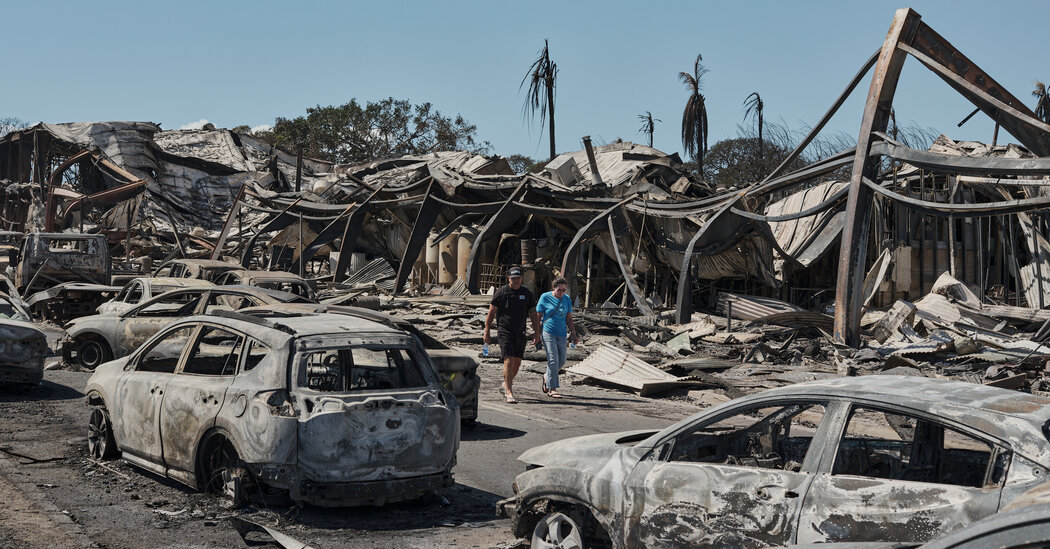As disasters like the wildfires that devastated the town of Lahaina, Hawaii, and storms that ripped roofs from Alabama to Massachusetts intensified last week, insurers are backing away from offering coverage in certain areas or slashing the types of damage they will pay to repair.
An unnoticed segment of the financial industry that provides insurance to insurers, called reinsurance, helped drive the changes.
These companies pledge to step in with cash—usually in huge sums—when something like a hurricane, wildfire, or other major disaster causes expensive and extensive damage that insurers have to pay for on their own. And at the beginning of the year, almost all of them raised prices.
In the weeks leading up to January 1, when about half of the reinsurance policies for the year were renewed, reinsurers broke the news to insurers across the United States and Canada—from large national carriers like State Farm and Farmers to smaller ones. And more specialized companies – that their prices were going up. This led to a wave of tense negotiations between those insurance companies and companies, such as Swiss Re, Odyssey Re, and other reinsurers, many of which are based outside the United States.
Franklin Nutter, president of the American Reinsurance Association, the trade group for the industry, said reinsurers have lost money over the past four or five years as they compete to offer customers the best terms. But late last year, they decided that competing in this way wasn’t worth the cost.
“The reinsurance community at large has decided we need a reset,” said Sean Kent, an insurance broker at FirstService Financial, which helps large housing projects find property insurance policies. “It was the most volatile in any reinsurance renewal history in decades.”
Increased rates for reinsurers have accelerated changes in an industry grappling with a new sense of uncertainty. The world is warming. storms are getting more intense; Inflation increased the cost of rebuilding after a disaster; A global increase in interest rates makes the money itself more expensive.
Since the beginning of the year, insurance companies have paid out $40 billion to American customers, which puts them on track for another yearly loss record. At every level, the costs of risk protection are rising, and everyone, from leaders of large corporations to homeowners and small businesses, is feeling the pressure.
“If you’re a CEO or CFO of a mid-market company — we’re talking about a 500-unit residential community in Minnesota — they talk about reinsurance and the impact of reinsurance on their bottom line and their profitability,” Mr. Kent said.
Reinsurance rates rose as much as 40 percent on Jan. 1 from a year earlier, according to a report from Gallagher Re, a brokerage firm that aggregates reinsurance coverage deals. The rate increases jolted insurance companies, who then made changes to where they offered insurance coverage. When State Farm announced in May that it would stop accepting new applications for certain California policies, it cited “The reinsurance market is full of challenges.Allstate also cited reinsurance costs when it paused some of its activities in California. Last month, reinsurers specializing in agricultural insurance announced that they are withdrawal from Iowaas it caused a severe wind storm about three years ago $4 billion in damage.
As a result of higher reinsurance costs, insurance companies have also raised rates where regulations allow. The cost of insurance has skyrocketed on large new developments in skeleton housing, the kind that have been popping up on the fringes of cities like Denver, Calgary, Alberta and across the Texas plains, according to Mr. Kent.
Severe thunderstorms in the United States account for nearly 70 percent of losses incurred by insurers around the world this year due to natural disasters, according to an Aug. 9 report by Zurich-based reinsurer Swiss Re. And the weather is unlikely to improve.
“It is very likely that we will see 2023 as the costliest year on record for thunderstorms in the United States,” said Steve Bowen, chief science officer at Gallagher Re.
To outsiders in the industry, it might seem strange that so many reinsurance companies, located in different parts of the world, would behave in the same way. But in the insurance industry, such herd-like movements are common, according to Michael Powers, a professor of finance at Tsinghua University in China and a former deputy insurance commissioner at Penn State.
“People in industry tend to be risk averse, they tend to look at the same data, they tend to see the world the same way,” Mr. Powers said.
Many industry experts, including Mr. Nutter, believe that reinsurance rates will remain high for a long time. They say insurers may have to raise rates even where they face the greatest resistance from regulators, who generally review rate increases in consumer insurance policies and have the right to block those they determine will generate excessive profits.
With the decline of reinsurers, some insurance companies are turning to other methods of securing cash reserves. The first, the disaster bond market, lets investors put up money that can be used to cover major disaster losses in exchange for small, regular payments that can add up to an attractive investment return. $7.1 billion in catastrophe bonds were issued during the second quarter of this year, a record high, according to Artemisa company that tracks the bond market.
But not all reinsurers have backed away from insurers in areas facing increased risks from natural disasters. The reinsurance business of Berkshire Hathaway, the group owned by Warren Buffett, recently concluded a $1 billion deal with Florida’s state-run insurance company, Citizens Property Insurance Corporation. It is the largest national cover agreement to date with a single conventional reinsurer.
Mr. Powers said reinsurance rates could drop sooner than most people expect, and reinsurers will only stay away for so long before they start to feel like they’ve lost something.
He said, “People realize that the sky has not fallen, and they want to make money.”
